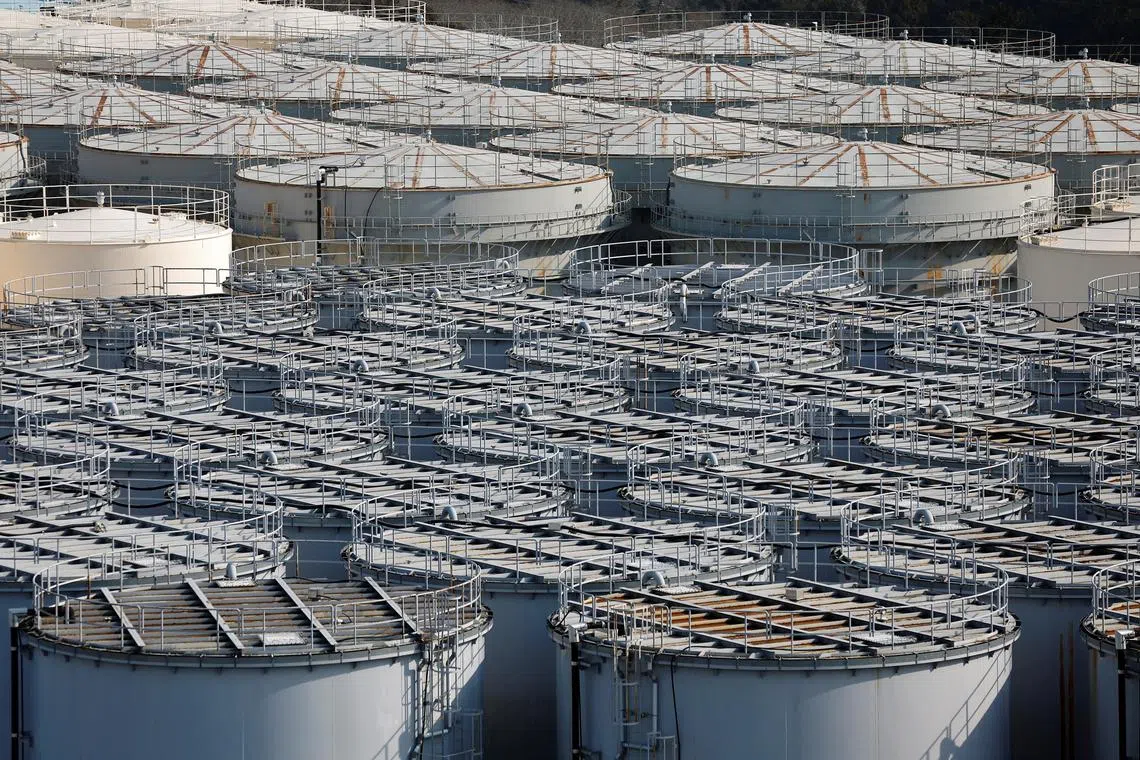Japan to release Fukushima water into ocean from Aug 24
Sign up now: Get insights on Asia's fast-moving developments

Japan has maintained that the water release is safe.
PHOTO: REUTERS
Follow topic:
TOKYO - Japan said on Tuesday that it will start releasing more than one million tonnes of treated water drawn strong criticism from China
The plan, approved two years ago by the Japanese government and viewed as crucial to decommissioning the plant operated by Tokyo Electric Power Company (Tepco), has also faced criticism from local fishing groups, who fear reputational damage and a threat to their livelihood.
“I have asked Tepco to swiftly prepare for the water discharge in accordance with the plan approved by the Nuclear Regulation Authority, and expect the water release to start on Aug 24, weather conditions permitting,” Prime Minister Fumio Kishida said on Tuesday morning.
The announcement comes a day after the government said it had won “a degree of understanding” from the fishing industry over the release of the water, even as a fishing group said it still feared the reputational damage would ruin livelihoods. The water will initially be released in smaller portions and with extra checks, with the first discharge totalling 7,800 cubic metres over about 17 days, starting on Thursday, Tepco said.
That water will contain about 190 becquerels of tritium per litre, below the World Health Organisation drinking limit of 10,000 becquerels per litre, according to Tepco. A becquerel is a unit of radioactivity.
Japan has maintained that the water release is safe. The International Atomic Energy Agency (IAEA), the UN nuclear watchdog, greenlighted the plan in July, saying it met international standards and the impact it would have on people and the environment was “negligible”.
About 56 per cent of respondents to a survey conducted by Japanese broadcaster FNN over the weekend said they supported the release, while 37 per cent opposed it.
“The IAEA and many other countries have said it’s safe, so I believe it is. But fishermen are facing so many problems so the Japanese government needs to do something to convince them,” said 77-year-old NGO worker Hiroko Hashimoto.
Scepticism abroad
Despite assurances, some neighbouring countries have expressed scepticism over the safety of the plan, with China emerging as the biggest critic.
Chinese foreign ministry spokesman Wang Wenbin called the move “extremely selfish”, saying Beijing was deeply concerned about the decision and had lodged a formal complaint. He said China “will take all necessary measures to protect the marine environment, food safety, and public health”, but did not mention any specific measures.
Hong Kong Chief Executive John Lee called the discharge “irresponsible” and said the city would “immediately activate” import controls on Japanese seafood from regions including the capital Tokyo and Fukushima, starting Thursday.
The ban, which will also be implemented by Macau, would cover live, frozen, refrigerated, dried seafood, as well as sea salt and seaweed.
South Korea said in a statement released on Tuesday that it sees no problem with the scientific or technical aspects of the plan, but did not necessarily agree with or support it. The matter has required President Yoon Suk-yeol to strike a balance as he seeks better relations with Japan while risking consumer backlash at home.
Despite the unease abroad, Mr Kishida said he believed an “accurate understanding” of the matter was spreading in the international community.
Japan says it will remove most radioactive elements from the water except for tritium, a hydrogen isotope that must be diluted because it is difficult to filter.
“There is an understandable perception that all radioactive materials are always and everywhere dangerous... but not all radioactive materials are dangerous,” Mr Tony Irwin, an honorary associate professor at the Australian National University, said in a note.
“Nuclear power plants worldwide have routinely discharged water containing tritium for over 60 years without harm to people or the environment, most at higher levels than the 22 terabecquerel per year planned for Fukushima,” he added.
A Japanese official said the first test results of the seawater after the discharge may be available at the start of September. Japan will also test fish in the waters near the plant, and make the test results available on the agriculture ministry’s website. REUTERS

